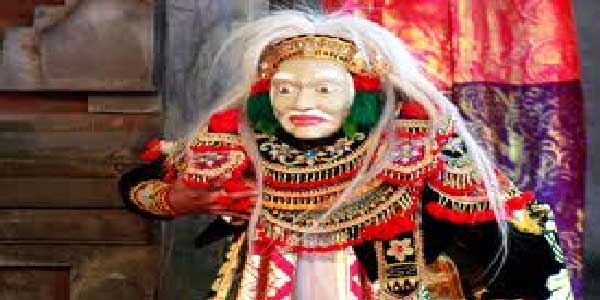
Baris Dance
Baris Dance is a traditional war dance, glorifies the manhood of the triumphant Balinese warrior.
Topeng Dance :: Balinese Dance

Topeng is an Indonesian form of dance drama in which one or more dancers wear masks and perform ancient stories, often concerning ancient or mythical kings and heroes. It has its origins in the 17th century. Topeng dances are most prevalent in Bali and Java but are also found in other Indonesian islands such as Madura (off the coast of East Java). The word "topeng" means mask in Indonesian. The dance is accompanied by gamelan music.
It is believed that the use of masks is related to the cult of the ancestors, which considered dancers the interpreters of the gods. Topeng performances open with a series of non-speaking, dancing masked characters that may not be related to the story that will be performed. These traditional masks often include "Topeng Manis" (a refined hero), Topeng Kras (a martial, authoritarian character), and Topeng Tua (an old man who may make jokes and draw the audience out).
The actual story is told by a narrator wearing a half-mask, thus enabling the actor to speak, called Penasar. In group topeng, there are usually two penasars providing two different points of view. The performance of the story alternates between speaking and non-speaking characters and may include dance sections, fights and special effects (sometimes provided by the gamelan orchestra), and it is almost always wrapped up by a series of comic characters introducing their own views.
The narrators and comic characters frequently break the conventions of storytelling by including current events or local gossip to get a laugh. In topeng, there is a conscious attempt to include many, sometimes contradictory, aspects of the human experience: the sacred and the profane, beauty and ugliness, refinement and caricature. A detailed description and analysis of "topeng pajegan," the one-man form of topeng, is available in "Masked Performance" by John Emigh, a western theater professor who has become a performer of Balinese topeng himself.
Balinese Dance :: Bali Culture Performance
Balinese dance is inseparable from religion. A small offering of food and flowers must precede even dances for tourists. Before performing, many dancers pray at their family shrines, appealing for holy "taksu" (inspiration) from the gods.

Baris Dance is a traditional war dance, glorifies the manhood of the triumphant Balinese warrior.

Oleg Tambulilingan Dance is a very sensual performance and mimics the mating dance of 2 bumblebees, the male obsessed with the female who elegantly and coyly keeps him away.

Barong is a character in the mythology of Bali. He is the king of the spirits, leader of the hosts of good, and enemy of Rangda in the mythological traditions of Bali.
The complate information about places of interest in Bali, places to visit, tourist sites, destinations, tourist object, and what to see in Bali Island
We provide the informations for temple ceremony and other ceremony in Bali, such as: Galungan Day, Kunungan Day, Nyepi Day and the other
Balinese dance is inseparable from religion. A small offering of food and flowers must precede even dances for tourists. Before performing, many dancers pray at their family shrines, appealing for holy "taksu" (inspiration) from the gods.
The centerpiece of any Indonesian meal is steamed or boiled rice.Accompanying dishes include various preparations of chicken, duck, beef, goat, all kinds of seafood and vegetables, either steamed, boiled, braised, stir or deep fried, roasted or grilled over coconut husks.